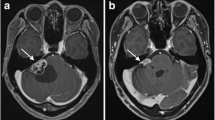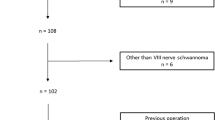Abstract
The objective of this study was to evaluate long-term vestibulocochlear functional outcomes of patients operated for unilateral vestibular schwannoma via the retro-sigmoid approach. Patients who underwent vestibular schwannoma resection via retro-sigmoid approach between 2004 and 2008 at our institution, without prior surgical or radio-surgical therapy were considered to be eligible for this study. Preoperative auditory and vestibular symptoms were assessed retrospectively. Postoperative symptoms were prospectively assessed using a standardised questionnaire, pure tone audiometry, video-oculography, and rotary chair testing. Out of a total of 203 patients, 120 were eligible for this study, of whom 64 responded to follow-up requests and could be enrolled. Serviceable hearing was reported in 42 patients (66 %) preoperatively and was maintained in 18 (43 %) postoperatively. While no significant change in rate of tinnitus and balance impairment between pre- and postoperative periods was detected, vertigo decreased significantly (40 to 28 %, p < 0.001). Postoperative video-oculography demonstrated vestibular paresis in 80 %. Rotary chair testing demonstrated normal or central compensation in 84 %. Absence of central compensation was associated with postoperative balance disturbance (p = 0.035). Increasing tumour size and patient age, also decreasing quality of preoperative hearing were independent factors predictive of a postoperative non-serviceable hearing (p = 0.020, p = 0.039 and p = 0.002, respectively). Resection of vestibular schwannoma via the retro-sigmoid approach is associated with improvement in postoperative vertiginous symptoms. Absence of central compensation leads to increased postoperative balance disturbances. Preservation of serviceable postoperative hearing is associated with good preoperative hearing status, younger age, and smaller tumours.


Similar content being viewed by others
References
Ryzenman JM, Pensak ML, Tew JM Jr (2004) Patient perception of comorbid conditions after acoustic neuroma management: survey results from the acoustic neuroma association. Laryngoscope 114(5):814–820
Saman Y, Bamiou DE, Gleeson M (2009) A contemporary review of balance dysfunction following vestibular schwannoma surgery. Laryngoscope 119(11):2085–2093
Gardner G, Robertson JH (1988) Hearing preservation in unilateral acoustic neuroma surgery. Ann Otol Rhinol Laryngol 97(1):55–66
House JW, Brackmann DE (1985) Facial nerve grading system. Otolaryngol Head Neck Surg 93(2):146–147
Dornhoffer JL, Helms J, Hoehmann DH (1995) Hearing preservation in acoustic tumor surgery: results and prognostic factors. Laryngoscope 105(2):184–187
Shelton C, Brackmann DE, House WF, Hitselberger WE (1989) Acoustic tumor surgery. Prognostic factors in hearing conversation. Arch Otolaryngol Head Neck Surg 115(10):1213–1216
Mangham CA, Skalabrin TA (1992) Indications for hearing preservation in acoustic tumor surgery. Am J Otol 13(2):137–140
Brackmann DE, Owens RM, Friedman RA, Hitselberger WE, De la Cruz A, House JW et al (2000) Prognostic factors for hearing preservation in vestibular schwannoma surgery. Am J Otol 21(3):417–424
Slattery WH 3rd, Brackmann DE, Hitselberger W (1997) Middle fossa approach for hearing preservation with acoustic neuromas. Am J Otol 18(5):596–601
Fischer G, Fischer C, Remond J (1992) Hearing preservation in acoustic neurinoma surgery. J Neurosurg 76(6):910–917
Mazzoni A, Biroli F, Foresti C, Signorelli A, Sortino C, Zanoletti E (2011) Hearing preservation surgery in acoustic neuroma. Slow progress and new strategies. Acta Otorhinolaryngol Ital 31(2):76–84
Nadol JB Jr, Chiong CM, Ojemann RG, McKenna MJ, Martuza RL, Montgomery WW et al (1992) Preservation of hearing and facial nerve function in resection of acoustic neuroma. Laryngoscope 102(10):1153–1158
Kameda K, Shono T, Hashiguchi K, Yoshida F, Sasaki T (2010) Effect of tumor removal on tinnitus in patients with vestibular schwannoma. J Neurosurg 112(1):152–157
Kohno M, Shinogami M, Yoneyama H, Nagata O, Sora S, Sato H (2014) Prognosis of tinnitus after acoustic neuroma surgery–surgical management of postoperative tinnitus. World Neurosurg 81(2):357–367
Van Gompel JJ, Patel J, Danner C, Zhang AN, Samy Youssef AA, van Loveren HR et al (2013) Acoustic neuroma observation associated with an increase in symptomatic tinnitus: results of the 2007–2008 Acoustic Neuroma Association survey. J Neurosurg 119(4):864–868
El-Kashlan HK, Shepard NT, Arts HA, Telian SA (1998) Disability from vestibular symptoms after acoustic neuroma resection. Am J Otol 19(1):104–111
Driscoll CL, Lynn SG, Harner SG, Beatty CW, Atkinson EJ (1998) Preoperative identification of patients at risk of developing persistent dysequilibrium after acoustic neuroma removal. Am J Otol 19(4):491–495
Humphriss RL, Baguley DM, Moffat DA (2003) Change in dizziness handicap after vestibular schwannoma excision. Otol Neurotol 24(4):661–665
Uehara N, Tanimoto H, Nishikawa T, Doi K, Katsunuma S, Kimura H (2011) Vestibular dysfunction and compensation after removal of acoustic neuroma. J Vestibular Res 21(5):289–295
Samii M, Matthies C (1997) Management of 1000 vestibular schwannomas (acoustic neuromas): surgical management and results with an emphasis on complications and how to avoid them. Neurosurgery 40(1):11–21 (Discussion -3)
Heerma H, Braun V, Richter HP (2000) Effect of microneurosurgical operation in acoustic neurinoma on symptoms of vertigo and tinnitus. Hno 48(5):372–377
Myrseth E, Moller P, Wentzel-Larsen T, Goplen F, Lund-Johansen M (2006) Untreated vestibular schwannomas: vertigo is a powerful predictor for health-related quality of life. Neurosurgery 59(1):67–76 (Discussion 67–76)
Battista RA (2009) Gamma knife radiosurgery for vestibular schwannoma. Otolaryngol Clin North Am 42(4):635–654
Lunsford LD, Niranjan A, Flickinger JC, Maitz A, Kondziolka D (2005) Radiosurgery of vestibular schwannomas: summary of experience in 829 cases. J Neurosurg 102(Suppl):195–199
Hillier SL, Hollohan V. Vestibular rehabilitation for unilateral peripheral vestibular dysfunction. The Cochrane database of systematic reviews. 2007(4):CD005397
Passier L, Doherty D, Smith J, McPhail SM (2012) Vestibular rehabilitation following the removal of an acoustic neuroma: a systematic review of randomized trials. Head Neck Oncol 4:59
Acknowledgments
We would like to thank Mr. Eik Vettorazzi, Department of Medical Biometry and Epidemiology, University Medical Centre Hamburg-Eppendorf, for the help with the statistical analyses. We are also thankful to the medical technologists, Department of Oto-Rhino-Laryngology, Head and Neck Surgery, University Medical Center Hamburg-Eppendorf, who were responsible for the audiometry, video-oculography and rotary chair testing.
Conflict of interest
The authors declare that they have no conflict of interest.
Ethical standard
“All procedures performed in studies involving human participants were in accordance with the ethical standards of the institutional and/or national research committee and with the 1964 Helsinki declaration and its later amendments or comparable ethical standards”.
Informed consent
“Informed consent was obtained from all individual participants included in the study”.
Author information
Authors and Affiliations
Corresponding author
Rights and permissions
About this article
Cite this article
Abboud, T., Regelsberger, J., Matschke, J. et al. Long-term vestibulocochlear functional outcome following retro-sigmoid approach to resection of vestibular schwannoma. Eur Arch Otorhinolaryngol 273, 719–725 (2016). https://doi.org/10.1007/s00405-015-3561-5
Received:
Accepted:
Published:
Issue Date:
DOI: https://doi.org/10.1007/s00405-015-3561-5




